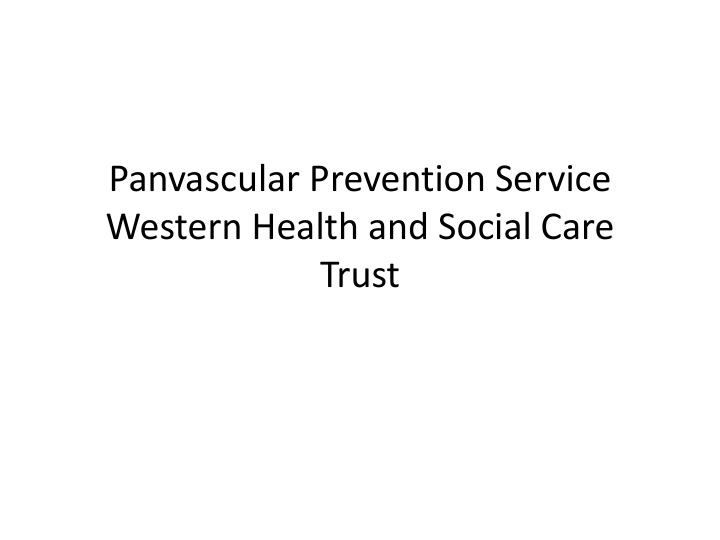



Panvascular Prevention Service Western Health and Social Care Trust
Why is need for change?
CVD and NI • In 2016 over 4,591 people in Northern Ireland were admitted to hospital with a heart attack whilst 3,784 people were admitted with a primary diagnosis of stroke • 1602 deaths were attributed to coronary heart disease and 1022 to stroke -24% of deaths in total • There are an estimated 225,000 people living with CVD in NI and with an aging and growing population these numbers could rise further • The annual spend on CVD in NI is £393 million
Adverse Lifestyles Northern Ireland • Smoking prevalence 20% (England 15%) • Obesity 26% • Diabetes mellitus 6% (England 4%) • Minority achieving recommended physical activity targets and only 1/3 eating 5 fruit and veg/day • High prevalence of psychological ill health also (highest suicide rate in UK)
Disease Predicted % change in numbers with disease 2015-2025 as a result of adverse lifestyles Cancer 180 Stroke 84 Dementia 86 CHD 22 Diabetes 118 Arthritis 91
“ This is the defining social issue of our time. The NHS and social care services are not coping now, yet within 20 years they will have to cope with 2.5 million older people with four or more chronic illnesses. We need to decide what kind of services we want over the next decade and what as a society we are willing to pay for .” Niall Dickson, chief executive of the NHS Confederation of health service leaders
Premature deaths and regional variation NI
Bengoa Review: Systems, Not Structures - Changing Health and Social Care 2016 “Growing acknowledgement that…..basic design (of healthcare) is around reactive episodic care and a weak focus on population health” “Even if these crisis decisions are handled in an effective way, they do not create in themselves the capacity for health systems to cope with the future challenges of demography, chronicity, prevention, fragmentation, sustainability and patient centeredness.
“The system should adopt a population health and well- being model with a focus on prediction and prevention rather than reaction ” Bengoa Review: Systems, Not Structures - Changing Health and Social Care 2016
Wood D A, et al Lancet 2008; 371: 1999-2012
Secondary Primary Prevention Prevention
Coronary arterial disease Diabetes Hypertension Peripheral Cerebral arterial arterial disease disease High CVD risk
MyAction: A Panvascular Prevention Programme Delivered by a Multidisciplinary Team in the Community MDT: Nurse/Physical Patient & partner attend the programme Activity specialist/Dietician Choice Equity of Access 16 week programme Smoking cessation Dietary and weight management Flexible Physical activity management Medical risk factor management Cardioprotective drugs Self efficacy and Psychosocial health self management Patient & partner reassessed at EOP Close liasion with primary and one year care
Comprehensive Programme • Patient and partner attend for 2.5 hrs once per week • Individual review of goals, medication etc. • Structured, minimal equipment exercise session • Health promotion sessions • Weekly MDT meeting with Physician • Liaising with GP & Practice Nurse
Cost effectiveness Benefits of the programme over a lifetime exceed its cost by £5609 per participant For every £1 invested in MyAction generates £6 in savings over a lifetime Incremental cost effectiveness ratio is £1,515
Editorial “The MyAction model exemplifies the future direction of modern preventive cardiology. Furthermore, economic analysis of similar programmes demonstrates the cost effectiveness of the MyAction model of preventive care”
5 th October 2018
Award and timelines • £486,000 this financial year (£972,000 year 2 and 3) • Money is dedicated for staffing not capital • Trust has agreed to recruit to permanent posts (n=20) • Posts being advertised mid October • Assembly full MDT by Nov/Dec 2018 • 5 day training programme • Programme launch December/Jan 2018
Western Trust Panvascular Programme • Existing CR service will be reconfigured into the new programme • Integration of both primary and secondary prevention population referred by primary and secondary care • Capacity for 1500 participants • Nurse-led multidisciplinary team (CV nurses, dieticians, physical activity specialists/physiotherapists/psychologists • Supported by consultant cardiologist • Delivered across 3 sites (AAH, OHPCC, SWAH) with involvement of community leisure centres
Stakeholder Engagement • Primary care • Secondary care • Local councils (Derry/Strabane, Tyrone/Fermanagh) • Community services • Voluntary Sector • Patient advocacy groups
Evaluation • Strong emphasis on measurement and recording of outcomes • Audit of clinical and patient-reported outcomes • Effect on readmissions and bed days saved
Recommend
More recommend